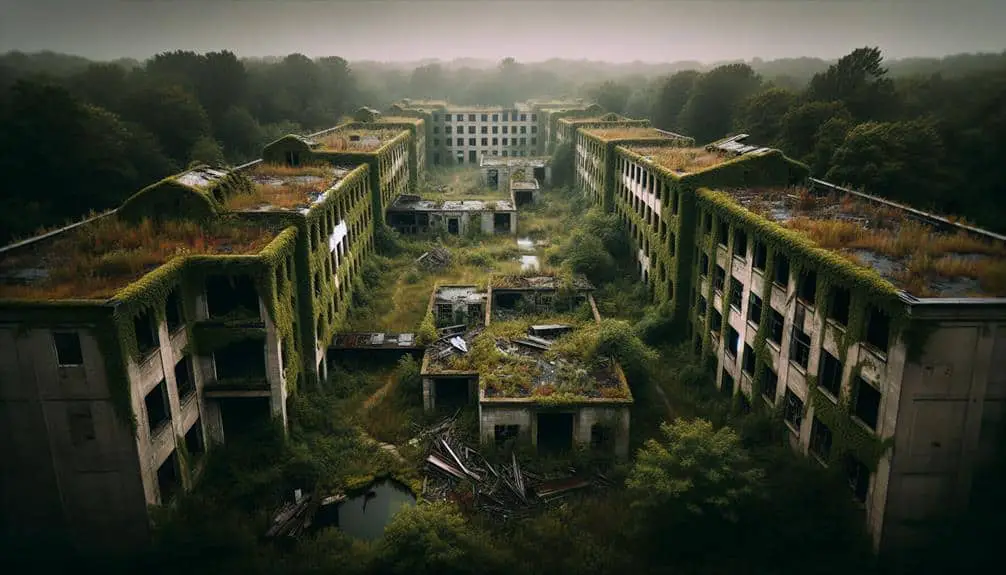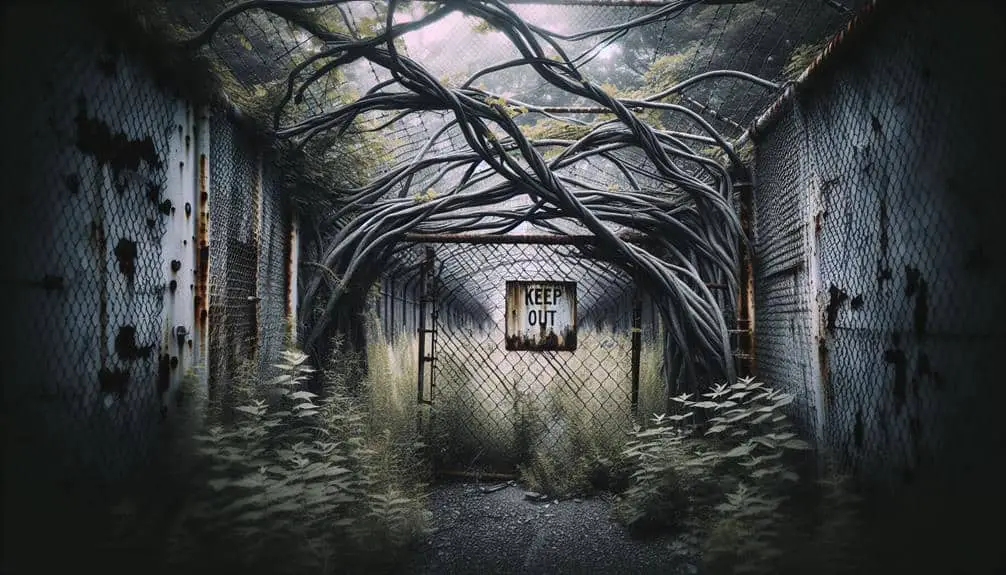Set out on a journey to uncover hidden gems of history at Fort Ord in California, Camp Hale in Colorado, Fort Totten in New York, Fort Desoto in Florida, Camp Livingston in Louisiana, Fort Hancock in New Jersey, Fort Stevens in Oregon, Camp Claiborne in Louisiana, and Camp Adair in Oregon. From forgotten barracks to reclaimed wildlife habitats, these abandoned military training camp ruins hold stories waiting to be heard. The crumbling walls and unique architectural features whisper tales of valor and military strategies. Each site offers a glimpse into the past, inviting you to explore and connect with history.
Key Points
- Fort Ord in California: Abandoned barracks and overgrown training grounds with ongoing environmental remediation efforts.
- Camp Hale in Colorado: Redevelopment plans for former military training site with recreational and wildlife preservation goals.
- Fort Totten in New York: Unique architectural features, historical significance, and strategic East River location.
- Fort Desoto in Florida: Exploration opportunities in military training camp ruins with wildlife sightings and historical convergence.
- Camp Livingston in Louisiana: Detailed history, restoration efforts, strategic military location, community impact, and memorialization initiatives.
Fort Ord in California
Exploring Fort Ord in California reveals a haunting landscape of abandoned barracks, overgrown training grounds, and forgotten history. The environmental impact of the military activities that once took place here is evident in the remnants left behind. However, remediation efforts have been underway to restore the land and mitigate the effects of pollution and habitat destruction.
For urban investigation enthusiasts, Fort Ord offers a unique opportunity to delve into a piece of history frozen in time. The decaying buildings and rusted equipment provide a glimpse into the past, while the vast expanse of the training grounds beckons to be explored.
Photography opportunities abound in Fort Ord, with its eerie yet captivating scenery. The juxtaposition of nature reclaiming the man-made structures creates a visually striking setting for photographers seeking to capture the beauty of abandonment. Whether you're drawn to the environmental impact, interested in urban investigation, or simply looking for photography inspiration, Fort Ord in California promises a memorable experience.
Camp Hale in Colorado
Nestled amidst the rugged Colorado landscape, Camp Hale stands as a demonstration to the military training exercises that once echoed through its valleys and peaks. The environmental impact of its past use is evident, with concerns about pollution and habitat disruption. However, there are promising redevelopment plans in place to revitalize the area while preserving its historical significance.
Despite its military history, Camp Hale now offers a unique blend of recreational opportunities and wildlife preservation. Outdoor enthusiasts can explore the scenic beauty of the surrounding White River National Forest through activities like hiking, camping, and fishing. Efforts to protect the native flora and fauna are underway, ensuring that the natural ecosystem thrives alongside human visitors.
As you wander through the remnants of Camp Hale, envision a future where the echoes of training exercises are replaced by the laughter of families enjoying nature. The transformation of this once military site into a haven for both people and wildlife symbolizes the enduring spirit of freedom and conservation.
Fort Totten in New York
Explore the historical significance of Fort Totten in New York, known for its unique architectural features that reflect the military training practices of its time.
Discover how the fort played a crucial role in the defense of New York City, offering a glimpse into the past and the strategies employed during different eras.
Uncover the secrets hidden within the walls of Fort Totten, showcasing a blend of history, architecture, and military tactics.
Historical Significance of Fort Totten
With its strategic location overlooking the East River, Fort Totten in New York holds a significant place in the history of military defenses in the United States. The fort played a vital role in military strategy, serving as a key defense post during the Civil War and both World Wars. Its construction was meticulously planned to enhance the military's ability to protect New York City and its surroundings.
Fort Totten's historical significance lies not only in its military importance but also in its architectural preservation. The well-preserved structures offer a glimpse into the past, showcasing the ingenuity and craftsmanship of the engineers and builders of that era. Exploring Fort Totten allows you to step back in time and appreciate the dedication to national defense and architectural excellence.
Architectural Features of Fort Totten
Fort Totten in New York showcases a remarkable display of architectural features that reflect the strategic and historical importance of this military site.
Exploring the architecture of Fort Totten allows you to witness a blend of different styles, ranging from the sturdy brick structures of the original fort to the more modern military buildings.
The fort's strategic location overlooking the Long Island Sound is evident in the layout of the structures and the defensive design elements incorporated into the buildings.
The historical significance of Fort Totten is palpable in the way the architecture tells a story of military operations and defense strategies of the past.
Take a walk through this site to appreciate the unique architectural features that have stood the test of time.
Fort Desoto in Florida
Nestled along the coast of Florida lies the historic military training camp ruins of Fort Desoto. This site offers a unique blend of exploration opportunities and wildlife sightings for those curious to uncover its secrets. As you wander through the remnants of Fort Desoto, you'll be captivated by the sense of history that surrounds you. The crumbling walls and overgrown pathways provide a glimpse into the past, allowing you to imagine the soldiers who once trained here.
Exploration opportunities abound at Fort Desoto, with hidden nooks and crannies waiting to be discovered. You can roam through the old barracks, envisioning the daily lives of the soldiers who called this place home. The sprawling grounds offer a sense of freedom as you traverse the abandoned structures, each one holding a piece of history within its walls.
Moreover, wildlife sightings are common at Fort Desoto, adding an element of natural beauty to the site. Keep an eye out for native birds, like ospreys and pelicans, soaring overhead, or perhaps catch a glimpse of playful dolphins in the nearby waters. Fort Desoto truly is a place where history and nature converge, providing a rich tapestry of experiences for those who seek adventure.
Camp Livingston in Louisiana
You can expect to learn about the detailed history of Camp Livingston, gain an overview of its current condition, and discover the latest updates on restoration efforts.
This information will provide you with a thorough understanding of the camp's past, present state, and future potential.
Stay tuned for in-depth insights into this fascinating abandoned military training camp in Louisiana.
Camp Livingston History
With a rich history dating back to World War II, Camp Livingston in Louisiana served as an essential training ground for thousands of soldiers during the war.
- Historical Significance: Camp Livingston played a crucial role in training troops for combat.
- Strategic Location: Situated in central Louisiana, the camp was strategically positioned for military operations.
- Training Facilities: The camp boasted state-of-the-art training amenities for soldiers.
- Community Impact: Camp Livingston had a significant influence on the local community and economy.
- Memorialization Efforts: There are ongoing endeavors to preserve the memory of Camp Livingston and its contribution to the war effort.
Current Condition Overview
The current state of Camp Livingston in Louisiana reveals a site weathered by time yet still holding echoes of its vibrant past as a pivotal military training ground during World War II. As you explore the grounds, you'll encounter dilapidated barracks, overgrown training fields, and remnants of the once-bustling infrastructure.
The camp's historical significance is palpable, offering a glimpse into the rigorous training that took place here decades ago. However, preservation challenges loom large, with the effects of weather and neglect evident everywhere. Despite these obstacles, the camp remains a fascinating destination for history enthusiasts and adventurers alike.
While exploring, remember to tread carefully and respect the site's heritage to safeguard that future generations can also appreciate its storied past.
Restoration Efforts Update
Amidst the remnants of Camp Livingston's storied past in Louisiana, ongoing restoration efforts are diligently working to breathe new life into this historic military training camp. The conservation initiatives and community involvement have been pivotal in driving the restoration progress forward.
Here are five key updates on the restoration efforts at Camp Livingston:
- Community volunteers have been actively participating in clean-up and restoration projects.
- Environmental impact assessments have guided restoration activities to guarantee minimal ecological disturbance.
- Historic buildings are being carefully restored to preserve the camp's unique architectural heritage.
- Educational programs are being developed to raise awareness about the camp's history and significance.
- Fundraising campaigns have been successful in securing financial support for ongoing restoration work.
Camp Claiborne in Louisiana
Nestled among the dense pine forests of central Louisiana lies the historic ruins of Camp Claiborne, a once vibrant military training facility that now stands as a haunting reminder of its past. The environmental impact of the abandoned camp has been a concern, prompting cleanup efforts to mitigate any potential hazards. Despite the decaying structures, nature has found a way to thrive within the camp's boundaries, turning it into a unique wildlife habitat. Various conservation initiatives have been put in place to protect the diverse flora and fauna that have made Camp Claiborne their home.
The remnants of Camp Claiborne tell a story of the past, echoing with the voices of soldiers who once trained within its grounds. Walking through the overgrown paths, you can almost feel the history that permeates the air. The rusted barracks and crumbling infrastructure stand as a confirmation to the passage of time, yet they hold a certain beauty in their decay. As you explore the ruins, you can't help but be captivated by the resilience of nature as it reclaims this once bustling military base.
Fort Hancock in New Jersey
Among the historic landmarks along the New Jersey coast, Fort Hancock stands out as a representation of the military history of the United States. This iconic fort, established in the late 19th century, served as an essential coastal defense post guarding the entrance to New York Harbor. Today, Fort Hancock stands as a proof of the valor and sacrifice of those who served within its walls.
- Preservation Efforts: Dedicated groups are actively working to protect the historic structures of Fort Hancock, ensuring that future generations can appreciate its importance.
- Restoration Projects: Ongoing restoration efforts aim to bring back the fort's former glory, allowing visitors to step back in time and experience its rich history.
- Historical Significance: Fort Hancock played a pivotal role in defending the nation during times of conflict, making its preservation vital.
- Educational Opportunities: The fort offers educational programs that explore its military past, providing valuable insights into the nation's defense strategies.
- Community Involvement: Local communities are coming together to support the restoration and preservation of Fort Hancock, recognizing its significance in American history.
Fort Stevens in Oregon
Explore the intriguing history of Fort Stevens in Oregon, from its role in coastal defense to its eventual abandonment.
Discover the allure of exploring the abandoned structures scattered throughout the fort, offering a glimpse into its past military operations.
Learn about the ongoing preservation efforts that aim to protect and showcase this piece of American military history for future generations.
Fort Stevens History
Have you ever pondered about the intriguing history of Fort Stevens in Oregon and its role in the military landscape of the United States? Fort Stevens, a key military installation, has a rich history that continues to captivate visitors.
Here are five fascinating aspects to ponder:
- Fort Stevens preservation efforts have guaranteed the site's historical significance is maintained.
- The fort boasts a diverse array of artifacts, offering a glimpse into its past military operations.
- Visitors can explore the underground gun batteries that once defended the Oregon coast.
- Fort Stevens played an essential role during World War II, facing a Japanese submarine attack in 1942.
- The fort provides a unique opportunity to dive into the military history of the Pacific Northwest.
Abandoned Structures Exploration
The remnants of abandoned structures within Fort Stevens in Oregon offer a haunting glimpse into a bygone era of military history and intrigue. As you explore the decaying barracks, rusting artillery batteries, and overgrown bunkers, you're met with a sense of exploration challenges and a unique beauty in the abandonment.
The crumbling walls and moss-covered buildings stand as proof to the passage of time and the resilience of these structures. Venturing through the deserted corridors and echoing chambers, you can't help but feel a mix of curiosity and reverence for the history held within these walls.
The exploration challenges you to navigate the maze of forgotten rooms and corridors, each revealing a piece of the past and adding to the allure of this abandoned site.
Preservation Efforts Today
Efforts to preserve the historic structures at Fort Stevens in Oregon have been meticulously planned and executed to maintain their integrity and cultural significance. The preservation challenges faced at Fort Stevens have spurred innovative solutions, ensuring the site's longevity. Engaging the community has been a cornerstone of the preservation efforts, providing volunteer opportunities for those passionate about history and conservation.
- Implementing sustainable restoration techniques.
- Conducting regular maintenance to prevent further deterioration.
- Hosting educational programs to raise awareness about the site's importance.
- Collaborating with local historians and experts for guidance.
- Offering hands-on workshops for volunteers to be directly involved in preservation activities.
Camp Claiborne in Louisiana
Nestled in the dense forests of Louisiana, Camp Claiborne stands as a haunting reminder of its once bustling military past. The preservation efforts at Camp Claiborne have been essential in maintaining the historical significance of this site. Established in 1939, the camp served as an important training ground during World War II, preparing troops for combat. Today, the remnants of Camp Claiborne include decaying buildings, overgrown roads, and abandoned training facilities, all shrouded in an eerie atmosphere.
Despite its current state of decay, Camp Claiborne holds a unique place in American military history. The site witnessed the training of thousands of soldiers, who later fought in major battles across the globe. As you wander through the overgrown ruins, you can almost hear the echoes of soldiers drilling and commanders strategizing.
Preserving Camp Claiborne isn't just about conserving physical structures; it's about honoring the sacrifices and bravery of those who trained here. The site stands as a tribute to the resilience and courage of the soldiers who once called it home.
Camp Adair in Oregon
Amidst the lush landscapes of Oregon lies Camp Adair, a once vibrant military training camp now left in ruins. Founded during World War II, Camp Adair holds significant historical value as one of the largest training centers in the Pacific Northwest. The camp's architectural details, including barracks, mess halls, and administrative buildings, offer a glimpse into the past and the military training that once echoed through the forests.
- Historical Significance: Camp Adair played an important role in training soldiers for combat during WWII.
- Architectural Details: The camp's structures showcase the military's utilitarian design style of that era.
- Abandoned Structures: Today, the barracks stand empty, covered in layers of moss and memories of bygone days.
- Preservation Efforts: Local groups are working to preserve what remains of Camp Adair to honor its historical importance.
- Exploration Opportunities: Visitors can wander through the overgrown ruins, imagining the stories of the soldiers who once trained there.
Frequently Asked Questions
What Specific Military Units Were Trained at Each of These Abandoned Training Camps?
When exploring military history, you'll discover that specific training camps hosted various units. Each camp's strategic importance and historical significance influenced the training techniques employed, shaping the soldiers who trained there.
Are There Any Rumored Paranormal Activities or Ghost Stories Associated With These Abandoned Military Training Camp Ruins?
When you explore paranormal investigations and urban exploration, you might come across chilling folklore and haunted legends. Ghost stories intertwine with abandoned ruins, inviting you to uncover the mysteries lurking within forgotten walls.
How Have Local Communities or Government Agencies Attempted to Preserve or Repurpose These Abandoned Military Training Camp Ruins?
Local communities have engaged in preserving these ruins through historical preservation efforts. Government agencies have also collaborated with community involvement initiatives to repurpose the abandoned military training camp ruins, ensuring their significance is respected and valuable resources are utilized efficiently.
Have There Been Any Notable Archaeological Discoveries or Artifacts Found at These Abandoned Military Training Camp Sites?
You'd be amazed by the archaeological finds at these abandoned military sites. Artifacts of historical significance are unearthed, fueling preservation efforts. Local communities engage in uncovering the past, shedding light on forgotten stories.
Are There Any Plans for Future Redevelopment or Restoration of These Abandoned Military Training Camp Ruins?
You should know that potential redevelopment of historical sites holds immense significance. Restoration efforts can preserve the past for future generations. It's important to honor the heritage and lessons these ruins offer.



